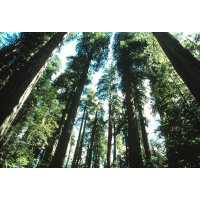Climate Change May Turn Trees from Carbon Fighters into Carbon Producers
 (photo: National Park Service)
(photo: National Park Service)
By Sean Duffy, Courthouse News Service
(CN) — For years, scientists have believed that the world's forests help to curb greenhouse gas emissions by absorbing carbon dioxide from the atmosphere. But new research suggests that climate change may turn North American forests into a "thermostat gone bad" that will eventually add carbon to the atmosphere instead of removing it.
Scientists from the University of Arizona in Tucson combined historic tree-ring records across North America, future climate model projections, and changes in the growth rates of trees stemming from a higher concentration of carbon dioxide in the atmosphere. Their findings were published Wednesday in the journal Ecology Letters.
This is the first study to demonstrate the potential impact of climate change on the growth rate of trees across North America, providing detailed forecast maps that depict how forest growth will by impacted across the continent.
"When forecasting responses to climate change, the degree to which increase atmospheric carbon dioxide might directly increase future plant growth, that is, 'carbon fertilization', remains an important unresolved effect," the study says.
In order to resolve uncertainties that can drastically affect climate models for the future, the researchers reviewed tree-rings and collected samples of trees from across North America.
Climate projections for North America developed by the International Panel for Climate Change were combined with historic tree-ring records, using samples covering the years 1900 to 1950 at 1,457 sampling sites across the continent.
"We then looked at how the growth of those trees changed historically under various past climates and used that to predict how they will grow in the future across the continent all the way from Mexico to Alaska," study co-author Noah Charney, a postdoctoral research associate at the University of Arizona, said.
The study calls into question previous conclusions about how forests will respond to warmer temperatures, shifting rainfall patterns and increased greenhouse gas emissions.
Climate scientists have long believed that the boreal greening effect — the assumption that trees in high latitudes where colder temperatures limited growth would absorb higher concentrations of carbon dioxide in the atmosphere due to a growth spurt from rising temperatures — will be a key component of an environmental reaction against climate change.
Margaret Evans, an assistant research professor at the University of Arizona, says the team found no evidence of the boreal greening effect in their simulations.
"Until now, there wasn't a good way to take into account how trees respond to climate change under novel climate conditions," Evans said. "Our study provides that perspective. We see that as trees are pushed under the effect of climate change, their response changes."
The group's projections indicate that the most dramatic changes in projected forest growth rates were seen in the interior West of North America, with up to 75 percent slower growth projected for trees in the Rockies, interior Canada and Alaska.
Increases in tree growth were found only along some coastal areas, primarily in Northeastern Quebec and the Maritime Provinces, the Pacific Northwest, and the Florida panhandle.
Evans said that some of the projections from the simulations are already occurring.
"In Alaska, for example, where trees have been projected to respond positively to warming temperatures under the boreal greening effect, we see that trees are now responding negatively instead," she said.
The findings also indicate that climate change is already pushing many forests toward the tipping point — where a forest can suddenly go from being a climate ally to actually producing carbon. Being rapidly exposed to higher temperatures forests have never experienced and are not evolutionarily prepared for hampers growth and makes trees more vulnerable to stress.
Projections suggest that the tipping point for many forests may be reached as early as 2050.
"There is a critical and potentially detrimental feedback loop going on here," Charney said. "When the growth rate of trees slows down in response to environmental stressors such as cold or drought, they can get by for a few years, but over time they deplete their resources and are much more susceptible to additional stressors, such as damage by fire or a big drought or insect outbreaks. Year after year of slow growth therefore means forests become less and less resilient."
Evans added, "It's like a thermostat gone bad. Forests act as a carbon sink by taking carbon dioxide out of atmosphere, but the more the climate is warming, the slower the trees are growing, the less carbon they suck up, the faster the climate is changing."
While the researchers only looked at samples from forests in North America, they said the implications may apply worldwide — and with even greater intensity.
"The boreal forests in Eurasia are more extensive and even more important than the ones in continental North America," Evans said.
To Learn More:
Observed Forest Sensitivity to Climate Implies Large Changes in 21st Century North American Forest Growth (by Noah D. Charney, Flurin Babst, Benjamin Poulter, Sydne Record, Valerie M. Trouet, David Frank, Brian J. Enquist, Margaret E. K. Evans, Ecology Letters) (abstract)
Biggest, Oldest Trees Most Likely to Succumb to Global Warming; Small Plants May be Spared (by Noel Brinkerhoff and Steve Straehley, AllGov)
Redwoods Faring Better than Humans in the Age of Global Warming (by Ken Broder, AllGov California)
- Top Stories
- Unusual News
- Where is the Money Going?
- Controversies
- U.S. and the World
- Appointments and Resignations
- Latest News
- Musk and Trump Fire Members of Congress
- Trump Calls for Violent Street Demonstrations Against Himself
- Trump Changes Name of Republican Party
- The 2024 Election By the Numbers
- Bashar al-Assad—The Fall of a Rabid AntiSemite






Comments